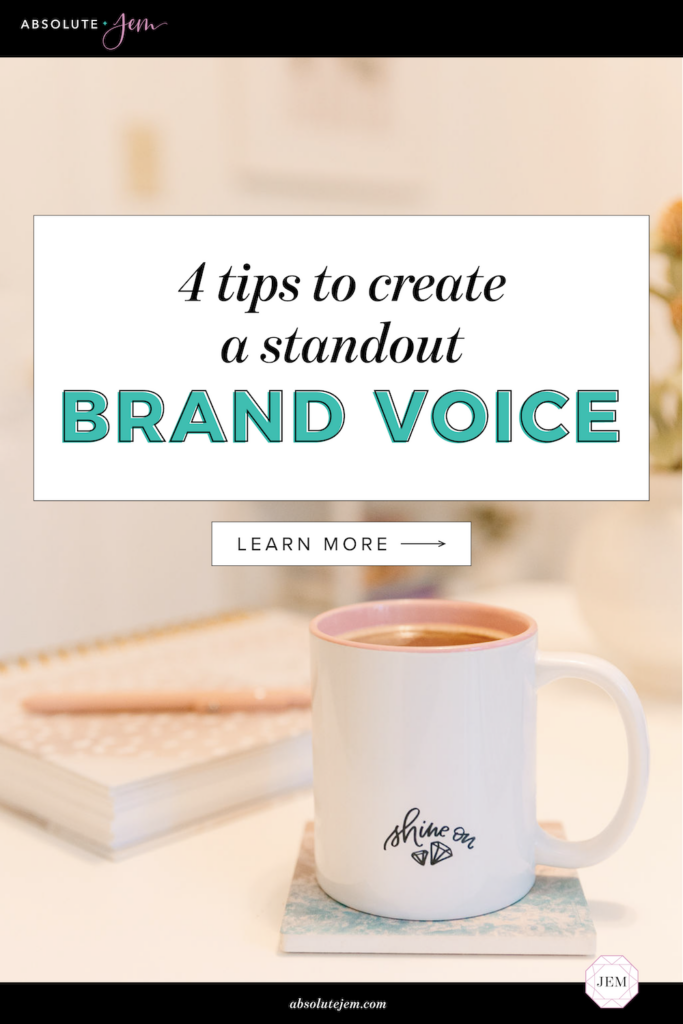Your brand “voice”, aka the language you use in your marketing, helps give your brand a distinct personality.
It’s the impression your followers get from the tone of your messaging—from social media captions, to web copy, to emails, to podcast interviews, and more. A strong verbal identity reflects the person, vision, and values behind the brand, which in turn helps form an emotional connection with the audience.
The last thing you want is a brand voice that’s confusing, inauthentic, or downright boring. Clear communication helps attract the right people by cutting through the noise and speaking directly to their needs. Your words are such a powerful tool to connect with your audience—which is why it’s so important to have a solid verbal brand identity!
So how do you figure out your brand’s linguistic personality? Here are my top 4 tips for zeroing in on your authentic, true-to-you brand voice.

1. Transcribe Your Talk
My favorite piece of copywriting advice is to “write like you talk.” Every person has a unique communication style, so try to hone in on yours as the first step to defining your brand’s voice. Give the following questions some thought:
How do you naturally talk or text in everyday life?
- Is your communication style fun and casual using slang and abbreviations, or do you stick to more professional language and grammar?
- When you text or email, are you boisterous and expressive using lots of emojis and exclamations, or more cool, calm, collected, and to the point?
- Do you have certain words or phrases you say all the time, or ones you’d never be caught dead saying?
- Do you lead with humor, or are you more serious?
- Do you swear unapologetically, or do you keep it clean?
Your “talk” can include everything from your coined catchphrases to your use of grammar to the flow of your sentences. It can even include the things you bring up consistently—like your affinity for wine, your beloved dog, or your favorite celebrity.
Figuring out your personal communication style is key to defining a voice for your brand. Especially for us small business owners—as oftentimes our brand voice and our personal voice are one and the same.
2. Consider Your Audience
Now that you’ve identified your own communication style, it’s time to consider your target market. Who is your ideal audience, and what kind of language do they use? What verbal expression would best appeal to them?
For example, if your ideal client is a young, laid-back beach-loving hipster, you’ll want to use a cool, casual, and conversational tone—whereas if your target audience is comprised of an older generation of professionals, you might want to come across as more formal.
By starting with your personal communication style as an authentic base, you can then filter your messaging through the lens of your target audience. A balance of these two styles is where the brand voice really comes to life.
3. Match Your Visuals and Values
It would be puzzling to see a crazy-colorful and whimsical visual brand paired with a really serious and monotonous corporate tone of voice. The goal here is to avoid confusion: You want your brand visuals and your brand voice to VIBE with each other in order to create a cohesive and holistic brand identity.
Take a look at your existing visual branding—from your logo, to your fonts, to your colors. What feeling do your visuals give off? Are they playful and whimsical? Sophisticated and modern? Luxurious and professional? Matching your brand voice to your visuals is a great way to nail down your brand's ideal verbal style.
And taking this a step further, you want your brand voice to match your core values as well. Just like an actual personality, your brand voice makes you stand out from your competitors with a distinct point of view, values, beliefs, opinions, and ideas. It’s crucial to building your know-like-trust factor and building authentic relationships and connections with your audience.
I like to say that an irresistible brand is built with 5 V's and that they all must mesh with each other to make brand magic.
4. Ask For Feedback
Sometimes we are too entrenched in our brand to see things objectively, so when in doubt, you should check in with your audience or others close to your brand to get their perspective.
A simple survey can work wonders. Simply poll your audience or colleagues by asking questions like:
- What words would you use to describe my personality?
- What words would you use to describe my brand?
- If my brand were a person, how would you describe its personality?
- If my brand were a celebrity or character, who would it be?
Analyzing the responses to these questions can provide valuable insights into shaping a brand voice that really resonates. You’ll begin to see a rhythm of what your audience likes and expects to see from your brand.
♦
Once you’ve pinpointed your brand’s communication style, stay true to that distinct voice and carry it through all of your brand communications. All the discovery work to find your WHY can’t just live in your head—it needs to be communicated to count! So shout out your superpowers, tell your story, speak up on matters you’re passionate about, and live out your brand’s values.
Let your voice be heard! Use these 4 tips to craft a standout brand voice that’s strong, distinct, authentic, and magnetic. Because it's not just what you say, but how you say it.